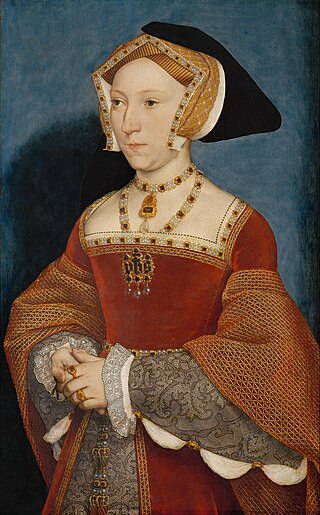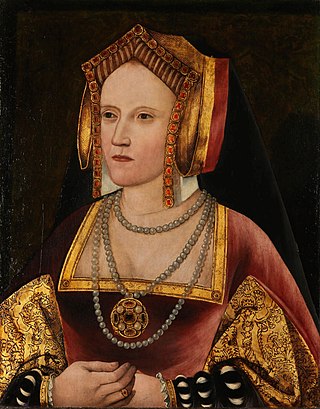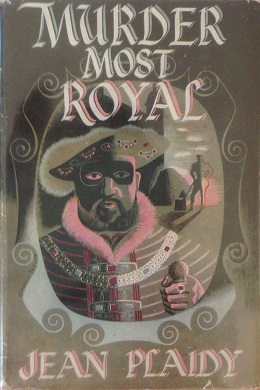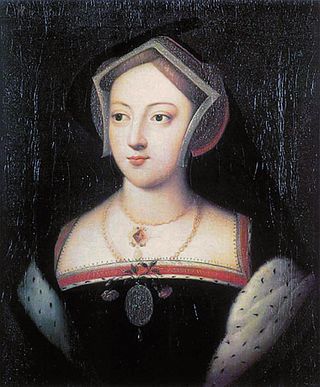Related Research Articles

The House of Tudor was a royal house of largely Welsh and English origin that held the English throne from 1485 to 1603. They descended from the Tudors of Penmynydd and Catherine of France. Tudor monarchs ruled the Kingdom of England and its realms, including their ancestral Wales and the Lordship of Ireland for 118 years with five monarchs: Henry VII, Henry VIII, Edward VI, Mary I and Elizabeth I. The Tudors succeeded the House of Plantagenet as rulers of the Kingdom of England, and were succeeded by the House of Stuart. The first Tudor monarch, Henry VII of England, descended through his mother from a legitimised branch of the English royal House of Lancaster, a cadet house of the Plantagenets. The Tudor family rose to power and started the Tudor period in the wake of the Wars of the Roses (1455–1487), which left the main House of Lancaster extinct in the male line.

Anne Boleyn was Queen of England from 1533 to 1536, as the second wife of King Henry VIII. The circumstances of her marriage and of her execution by beheading for treason and other charges made her a key figure in the political and religious upheaval that marked the start of the English Reformation. Anne was the daughter of Thomas Boleyn, 1st Earl of Wiltshire, and his wife, Elizabeth Howard, and was educated in the Netherlands and France, largely as a maid of honour to Queen Claude of France. Anne returned to England in early 1522, to marry her Irish cousin James Butler, 9th Earl of Ormond; the marriage plans were broken off, and instead, she secured a post at court as maid of honour to Henry VIII's wife, Catherine of Aragon.

Anne of the Thousand Days is a 1969 British period historical drama film based on the life of Anne Boleyn, directed by Charles Jarrott and produced by Hal B. Wallis. The screenplay by Bridget Boland and John Hale is an adaptation of the 1948 play of the same name by Maxwell Anderson.

Jane Seymour was Queen of England as the third wife of King Henry VIII of England from their marriage on 30 May 1536 until her death the next year. She became queen following the execution of Henry's second wife, Anne Boleyn. She died of postnatal complications less than two weeks after the birth of her only child, the future King Edward VI. She was the only wife of Henry to receive a queen's funeral or to be buried beside him in St George's Chapel, Windsor Castle.
The Six Wives of Henry VIII is a series of six television plays produced by the BBC and first transmitted between 1 January and 5 February 1970. The series was later aired in the United States on CBS from 1 August to 5 September 1971 with narration added by Anthony Quayle. The series was rebroadcast in the United States without commercials on PBS as part of its Masterpiece Theatre series.
Jane Boleyn, Viscountess Rochford, was an English noblewoman. Her husband, George Boleyn, Viscount Rochford, was the brother of Anne Boleyn, the second wife of King Henry VIII. Jane had been a member of the household of Henry's first wife, Catherine of Aragon. It is possible that she played a role in the verdicts against, and subsequent executions of, her husband and Anne Boleyn. She was later a lady-in-waiting to Henry's third and fourth wives, and then to his fifth wife, Catherine Howard, with whom she was executed.

Thomas Howard, 3rd Duke of Norfolk, was a prominent English politician and nobleman of the Tudor era. He was an uncle of two of the wives of King Henry VIII, Anne Boleyn and Catherine Howard, both of whom were beheaded, and played a major role in the machinations affecting these royal marriages. After falling from favour in 1546, he was stripped of his Dukedom and imprisoned in the Tower of London, avoiding execution when Henry VIII died on 28 January 1547.
Mark Smeaton was a musician at the court of Henry VIII of England, in the household of Queen Anne Boleyn. Smeaton, together with the Queen's brother George Boleyn, Viscount Rochford, Henry Norris, Francis Weston and William Brereton was executed for treason and adultery with Queen Anne.

In common parlance, the wives of Henry VIII were the six queen consorts of King Henry VIII of England between 1509 and his death in 1547. In legal terms, Henry had only three wives, because three of his marriages were annulled by the Church of England. However, he was never granted an annulment by the Pope, as he desired, for Catherine of Aragon, his first wife. Annulments declare that a true marriage never took place, unlike a divorce, in which a married couple end their union. Along with his six wives, Henry took several mistresses.

The Tudors is a historical fiction television series set primarily in 16th-century England, created and written by Michael Hirst and produced for the American premium cable television channel Showtime. The series was a collaboration among American, British, and Canadian producers, and was filmed mostly in Ireland. While named after the Tudor dynasty as a whole, it is based specifically upon the reign of King Henry VIII.

Henry VIII is a two-part British television serial produced principally by Granada Television for ITV from 12 to 19 October 2003. It chronicles the life of Henry VIII of England from the disintegration of his first marriage to an aging Spanish princess until his death following a stroke in 1547, by which time he had married for the sixth time. Additional production funding was provided by WGBH Boston, Powercorp and the Australian Broadcasting Corporation.

Henry VIII and His Six Wives is a 1972 British historical film adaptation, directed by Waris Hussein, of the BBC 1970 six-part miniseries The Six Wives of Henry VIII. Keith Michell, who plays Henry VIII in the TV series, also portrays the king in the film. His six wives are portrayed by different actresses, among them Frances Cuka as Catherine of Aragon, and Jane Asher as Jane Seymour. Donald Pleasence portrays Thomas Cromwell and Bernard Hepton portrays Archbishop Thomas Cranmer, a role he had also played in the miniseries and briefly in its follow-up Elizabeth R.
Events from the 1530s in England.
Young Royals is a series of novels for children by Carolyn Meyer based on the early lives of multiple royalties such as English and French royalty. Books in the series are mostly about the English Tudors, such as: Mary, Bloody Mary (1999); Beware, Princess Elizabeth (2001); Doomed Queen Anne (2002); and Patience, Princess Catherine (2004). The French books in the series are Duchessina (2007), about the life of Catherine de' Medici, and The Bad Queen: Rules and Instructions for Marie-Antoinette (2010). The most recent titles in the series are: The Wild Queen: The Days and Nights of Mary, Queen of Scots (2012); Victoria Rebels (2013), about Queen Victoria of the British Empire; and Anastasia and Her Sisters (2013), about the daughters of Tsar Nicholas of Russia, specifically Anastasia.

Murder Most Royal (1949) is an historical fiction novel by Jean Plaidy.

Henry VIII and his reign have frequently been depicted in art, film, literature, music, opera, plays, and television.
Sir Edward Bayntun, of Bromham, Wiltshire, was a gentleman at the court of Henry VIII of England. He was vice-chamberlain to Anne Boleyn, the King's second wife, and was the brother-in-law of Queen Catherine Howard, Henry VIII's fifth wife.
Anne Boleyn is a play on the life of Anne Boleyn by the English author Howard Brenton, which premiered at Shakespeare's Globe in 2010. Anne Boleyn is portrayed as a significant force in the political and religious in-fighting at court and a furtherer of the cause of Protestantism in her enthusiasm for the Tyndale Bible.

The mistresses of Henry VIII included many notable women between 1509 and 1536. They have been the subject of biographies, novels and films.
Sir Richard Page was an English courtier. He was a gentleman of the Privy Chamber at the court of Henry VIII of England, and Vice-Chamberlain in the household of Henry VIII's illegitimate son, Henry FitzRoy. Page was imprisoned in the Tower of London in 1536 during the downfall of Anne Boleyn. He married Elizabeth Bourchier, the mother-in-law of the Protector Somerset
References
- ↑ Block, Geoffrey."Anatomy of a Flop" The Richard Rodgers Reader (books.google.com), Oxford University Press US, 2006, ISBN 0-19-531343-7, p. 247
- ↑ Barnes, Clive (26 April 1976). "'Rex' by Rodgers Stars Williamson". The New York Times. New York City. p. 32. Retrieved 22 May 2017.
- ↑ Kenrick, John."'Rex' - Original Broadway Cast (RCA) Musicals101.com, accessed April 10, 2011
- ↑ Jones, Kenneth.Rodgers and Harnick's Rex, with Errico, Gets NYC Concert Reading, Oct. 13-15" playbill.com, October 13, 2000
- ↑ Ouzounian, Richard.A train wreck gets new wheels" thestar.com, February 11, 2010
- ↑ Lawrence, Mark Andrew.Review: 'Rex' at Fairview Library Theatre" broadwayworld.com, February 24, 2010